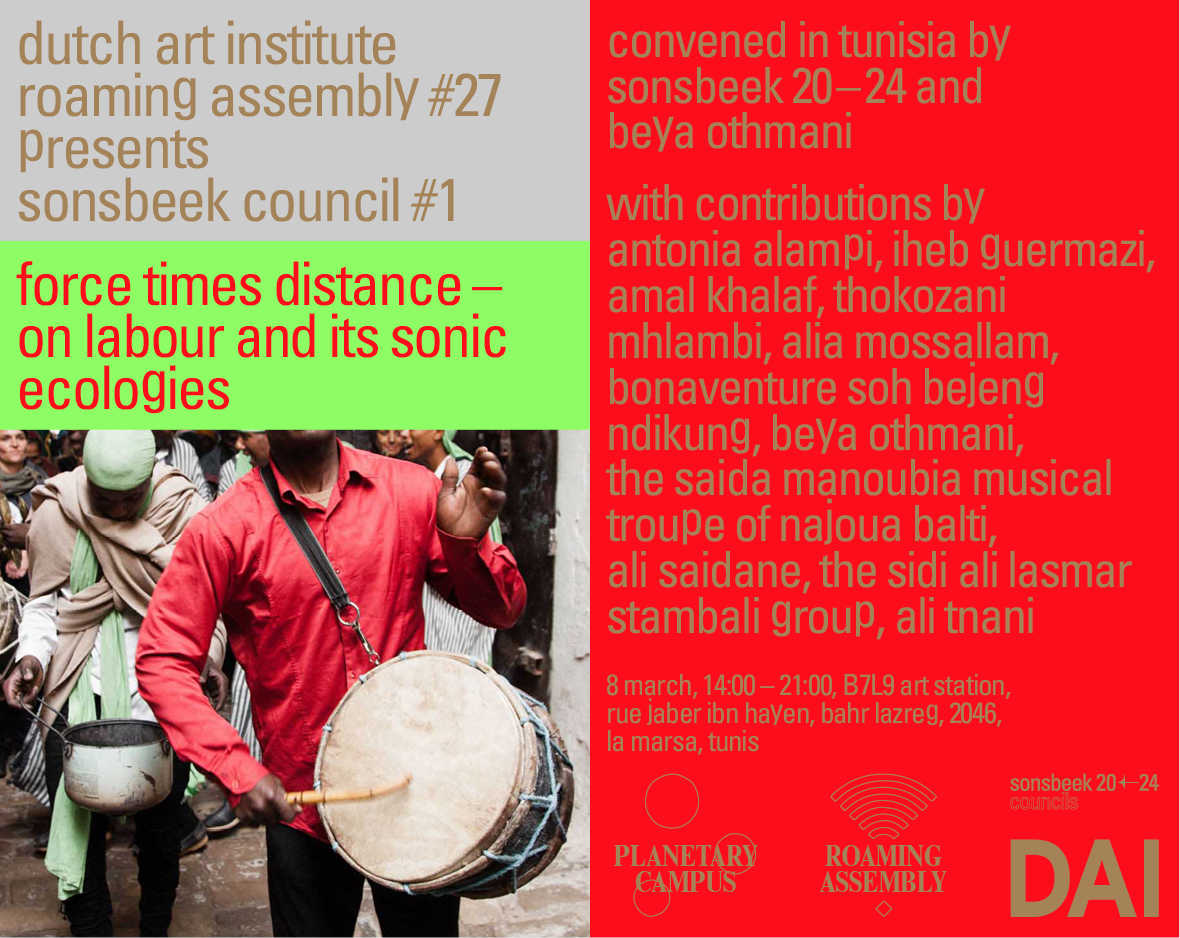2020 ~ Roaming Assembly# 27 presents Sonsbeek Council #1 Force Times Distance - On Labour and its Sonic Ecologies ~ Introductions by Antonia Alampi, Bonaventure Soh Bejeng Ndikung & Beya Othmani
Sonsbeek Council #1: Force Times Distance - On Labour and its Sonic Ecologies is the first act in the framework of sonsbeek´s extended and dis-placed program. The sonsbeek Councils situate themselves beyond the Netherlands in an effort to create alliances, think together, relate and flesh out the concerns of sonsbeek20→24 with artists, curators, activists, theoreticians and other practitioners within other geographies and other sociopolitical realities.
This opening chapter will consist of a seamless flow of contributions from 2 and until 9pm including music, performances, films, panel discussions and lectures. We begin by listening to the spiritual in its coexistence with the rhythms imposed by value production. With the Hadhra of Saida Manoubia we hear the invisible spirits of the saint patrons of Tunis, and the mystical labour of healers and musicians operating in their shrines. With the Stambali group Sidi Ali Lasmar, performing musical interludes throughout the program, we lend an ear to the histories of enslaved people, their descendants, their ancestors, saints and jins as written into the Stambali musical tradition. Among others, we will deliberate on how spaces of sex labour in Tunisia were shaped over time by colonial forces, how labour in the waters of the Nile has shaped different musicalities and listen to sonic interpretations of the experiences of izinyanga zensimbi (pre-colonial metalworkers in KwaZulu, Africa)
The title, just like sonsbeek´s next edition, takes its cue from the physics formula for work = force X distance, but metaphorically it invokes the work as in labour conditions, force as in disproportionate power gradients, times as in the non-linear understandings of the notion of time, and the collapsing of distances, as in the here and there. At the crux of the project is the possibility of deliberating on notions of and relations between work/labour and the sonic, and the possibility of thinking about the history of labour and conditions of work through sonicity.
It is an invitation to delve into socioeconomic relationships as framed by race, gender, class structures and politics, as well as how these are manifested in the sonorous. The idea is to tackle the myriad of unheard stories and hardly visible professions that make things be but are rarely represented and the ones that have been rigorously and malevolently erased from collective history. To provide space for listening to experiences of the labour force that erects and builds, that serves and provides, that protects and cares, however merely – if at all - acts as a support or minor role in most representations. It aims to invoke, evoke, provoke new thoughts, ideas and perceptions, engage with an expanded and augmented musicality that invites and encourages different modes of listening, that want to make visible which is already there but remains unseen and unheard, that recover, restitute and repair the still segregative conditions under which we live, between visible and invisible workers, bodies and lands.
OVERVIEW:

